Unfortunately, many men experience unsightly bumps on their necks after shaving. And not only are they unattractive. They are itchy, painful, and often sensitive! If you struggle with this uncomfortable problem, there is good news. Here's how you can get rid of razor bumps on the neck.
To get rid of razor bumps on the neck, men can use topical washes or creams to reduce inflammation. Those who suffer from razor bumps, also called barber bumps, can speed healing by letting neck and facial hair grow naturally.
If you’re wondering about how to use over-the-counter remedies to get rid of razor bumps on the neck, read on.
The best solution for razor bumps on the neck is to stop shaving. Shaving leaves behind hairs with sharp tips just under the skin’s surface. As hairs regrow, they can turn and grow into the skin. That results in razor bumps on the neck.
Razor bumps on the neck appear as raised pimple-like cysts on the skin’s surface. Typically, this happens 2-3 days after shaving the face, chin, or neck. So, what can be done about these bothersome bumps?
Here are some solutions for razor bumps on the neck.
Fortunately, men find products formulated for razor bumps at pharmacies, drug stores, or online retailers. When looking for a cream, lotion, or gel to treat razor bumps, watch for a solution to reduce inflammation, swelling, and discoloration.
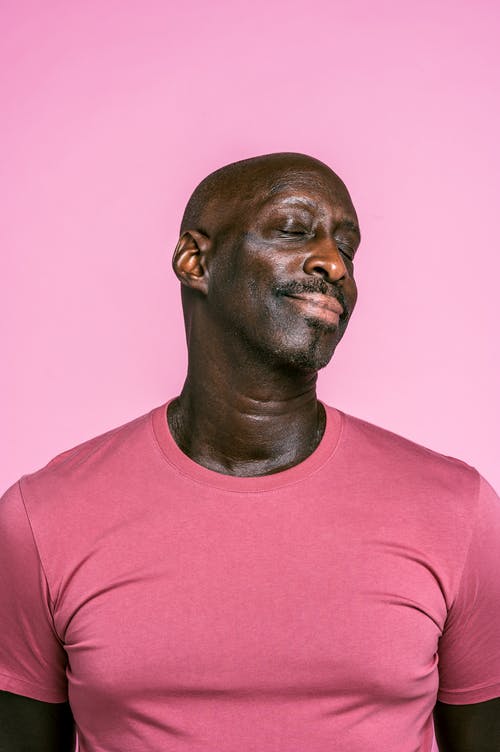
Getting rid of razor bumps on the neck is one issue. But perhaps you grew out your beard to finally get rid of them, and now you’re faced with the need to shave again.
The last thing you want is another case of razor bumps. Here are some tips to stop getting razor bumps on the neck. For men who have to shave for personal or professional reasons, the key is to focus on ways to reduce or prevent razor bumps.
Here are three ways to stop getting razor bumps on the neck.
Dermatologists recommend training unruly hair to grow straight rather than curly. Straightening new hair growth may prevent sharp edges from curling into the skin and causing razor bumps, as hair regrows.
Use a soft bristle brush to train the hair. Stroke the hairs in one direction.
You can find a brush made especially for beards, or use a new soft bristle toothbrush. Consistency is key. Make sure to do this daily to see improvement over time.
Many men use after-shave but are you using a pre-shave? Expert doctors recommend using a pre-shave before shaving cream to help protect skin while making shaving a smoother process. Massaging a pre-shave product into the neck and facial hair makes beard hairs lift to the razor. Look for labels with these ingredients.
An important part of preventing razor bumps on the neck is using the right shaving technique. A dermatologist will tell you to avoid shaving against the grain. That is because this method will reduce the risk of razor bumps. On the neck, this can be hard. Usually, hair on the neck grows in multiple different directions. Use a mirror to examine the direction of hair growth before you take a razor to it. After you find how your facial hairs are growing, glide the razor along that direction next time you shave, and you should see a difference.
In short, you don’t have to suffer from razor bumps on your neck after every shave. Now you know what at-home solutions you can try to get rid of them quickly. Using these tips for shaving and skincare, you can battle these bumps.
For skin conditions that don’t resolve on their own or get worse, you can talk to an expert at Razor Bumps, Inc.
Disclaimer: The contents of this article are for informational purposes only and do not constitute medical advice. The information, graphics, and images on this site are not intended to substitute diagnosis or treatment by a medical professional. Always seek the advice of a licensed physician for any questions you may have regarding a specific condition.
Razor bumps are uncomfortable. If you have this unfortunate skin rash from shaving, you probably wonder how long razor bumps last.
It is tough to say how long razor bumps last because each case is different. In general, a true case of razor bumps, also called Pseudofolliculitis Barbae (PFB), can last one month or more. Factors such as how the skin is cared for and what products are applied can affect the healing time for razor bumps.
If you’re wondering why skincare matters when it comes to healing razor bumps, and what you can do to get the problem to go away faster, you are not alone. Read on to learn more.
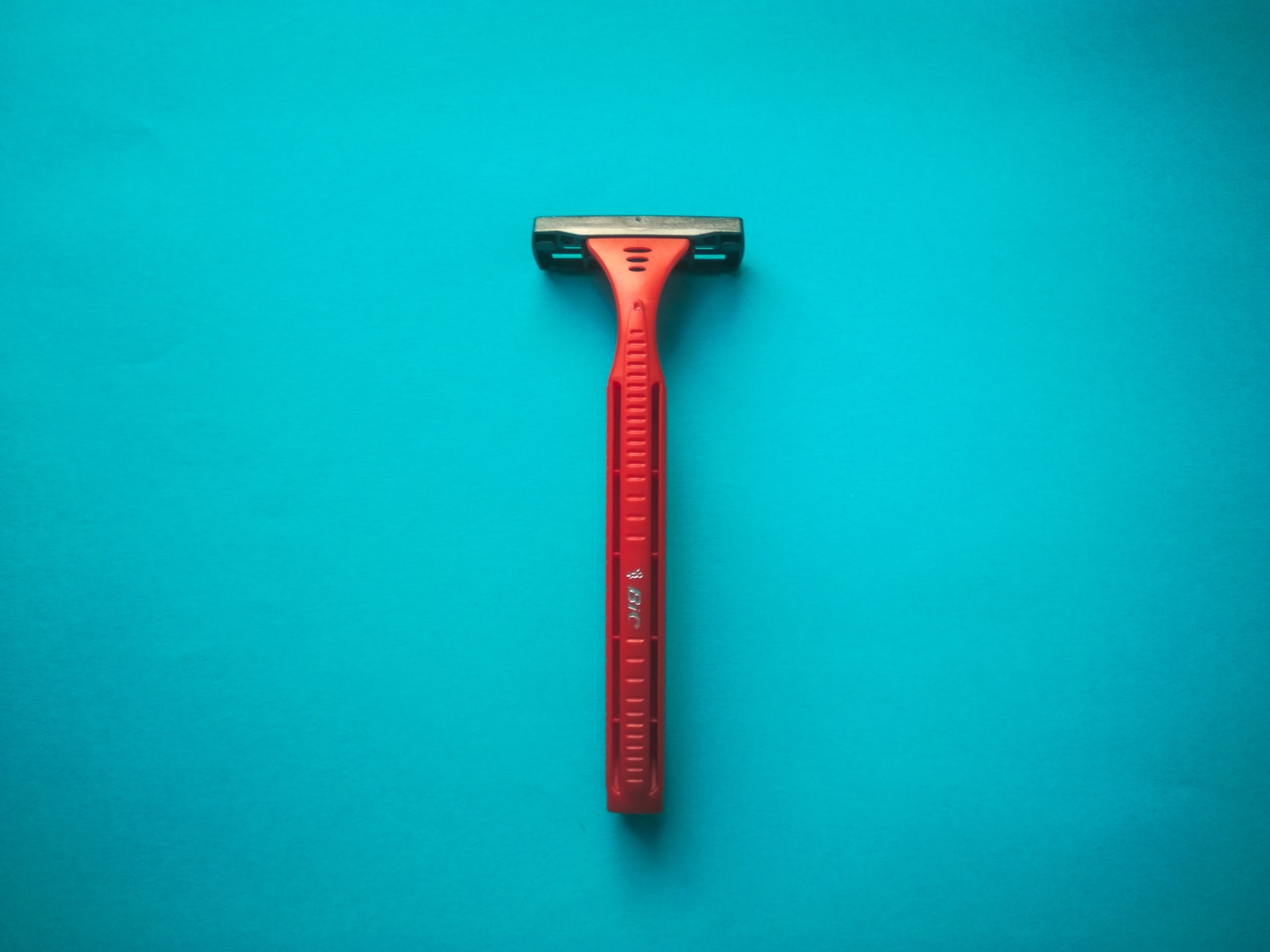
Razor bumps, or PFB, are caused by the natural process of hair growth when it is interrupted by shaving for hair removal. Most commonly PFB occurs on the face and neck but can affect other parts of the body, such as the underarms or thighs. To understand how long razor bumps last, let’s look at how razor bumps begin. It all starts with hair growth.
Hair growth begins with the anagen phase. That is the “growing” phase. During this time, a matrix of cells rapidly multiplies under the skin. This process pushes the older cells of the hair strand out from the skin’s surface. According to the American Academy of Family Physicians, 85 to 90 percent of hairs are in this anagen phase. The remaining hairs are in stages of rest when hair eventually dies or falls out. Hair growth is what causes razor bumps to appear in the first place.
After shaving, facial hair begins to regrow. Sometimes, hairs can curl and regrow in the wrong direction. According to the American Osteopathic College of Dermatology, when body hair, such as a beard, curves and tries to grow back into the skin, the body responds with inflammation and a foreign body reaction. Swollen, reddened, painful bumps appear on the skin as the hair grows. As you can see from the chart, it may take a few days for razor bumps to show up after shaving.
Post-shave razor bumps can also appear as:
These bumps may also bleed easily and can become infected. In some cases, you might see hairs trapped under the skin’s surface. These are called ingrown hairs. These signs indicate a case of razor bumps that will go on if the is responding to the trauma.
Studies show that razor bumps usually go away on their own when you stop shaving.
Hair growth patterns vary depending on a person’s age, sex, and genetics. The average man’s beard grows about 0.27 mm every 24 hours. Consider this timeline.
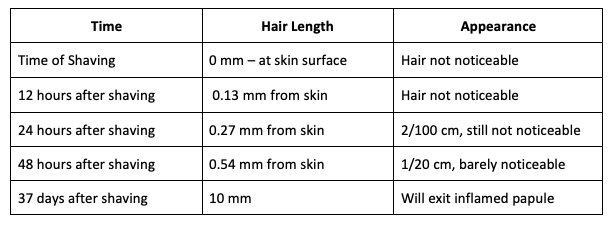
If left to grow to a length of approximately 10 mm, the entrapped hair will exit the inflamed pocket. In other words, the hair will work its way out of the skin. This growth typically takes approximately five weeks, or 37 days, when growing at 0.27 mm per 24 hours.
Another option is to remove ingrown hairs mechanically. For example, tweezing is one method to remove hairs that have grown back into the skin.
On the other hand, if shaving continues, skin damage can worsen. So will the case of razor bumps. In this case, the skin will continue to respond with inflammation. Signs and symptoms will worsen. Over time, a prolonged inflammatory response can cause a condition known as post-inflammatory hyperpigmentation. It is a type of skin discoloration that is worse in darker skin types. PFB can also lead to permanent scarring. If you have hyperpigmentation, a doctor can recommend over the counter treatments to lessen the appearance of dark spots.
If you have razor bumps, you don’t have to wait for them to go away on their own. Most cases of razor bumps will improve faster with a few simple steps you can take at home. The keys to speed healing are to lower inflammation and to prevent infection. Here are a few steps that can do just that.
1. Wash your clothing thoroughly. That means cloth masks over the face or clothing worn over other body parts. Clothes collect dead skin cells and bacteria that could cause inflammation or infection if worn over skin affected by razor bumps.
2. Cleanse the area with gentle antibacterial soap. Avoid reusing washcloths or using body poufs. Using a clean cloth each time will prevent bacteria from irritating skin more.
3. After cleaning the skin, apply a moisturizer to the area. Lotions and creams with salicylic acid can also help symptoms.
4. Consider over-the-counter products to reduce inflammation and prevent infection. Some of these options include antibiotic ointment or hydrocortisone cream. Natural plant-based and herbal remedies such as tea tree oil or witch hazel calm aggravated skin.
5. Avoid further irritation. Avoid shaving the area again until the bumps go away. When razor bumps are in the face or neck areas, it might be necessary to grow a beard. While the hair is growing, keep the hair clean to prevent skin infection.
You should see a medical professional when razor bumps don’t go away. If you try these steps to soothe the skin, but your signs and symptoms become worse, a doctor should evaluate your razor bumps.
If you stop shaving, but the bumps do not resolve in 4-5 weeks, a healthcare provider should evaluate the skin condition. Some cases might require medication, prescription cleansers, special creams, or other treatments.
While it’s true that severe cases of razor bumps can cause permanent skin damage, don’t jump to that conclusion right away if you are worried about stubborn bumps that just don’t go away, make an appointment to talk with a healthcare provider.
Now that you know how long razor bumps last and what causes them use these tips to get rid of bumps faster. And when home care doesn’t work, talk to your doctor.
Disclaimer: The contents of this article are for informational purposes only and do not constitute medical advice. The information, graphics, and images on this site are not intended to substitute diagnosis or treatment by a medical professional. Always seek the advice of a licensed physician for any questions you may have regarding a specific condition.
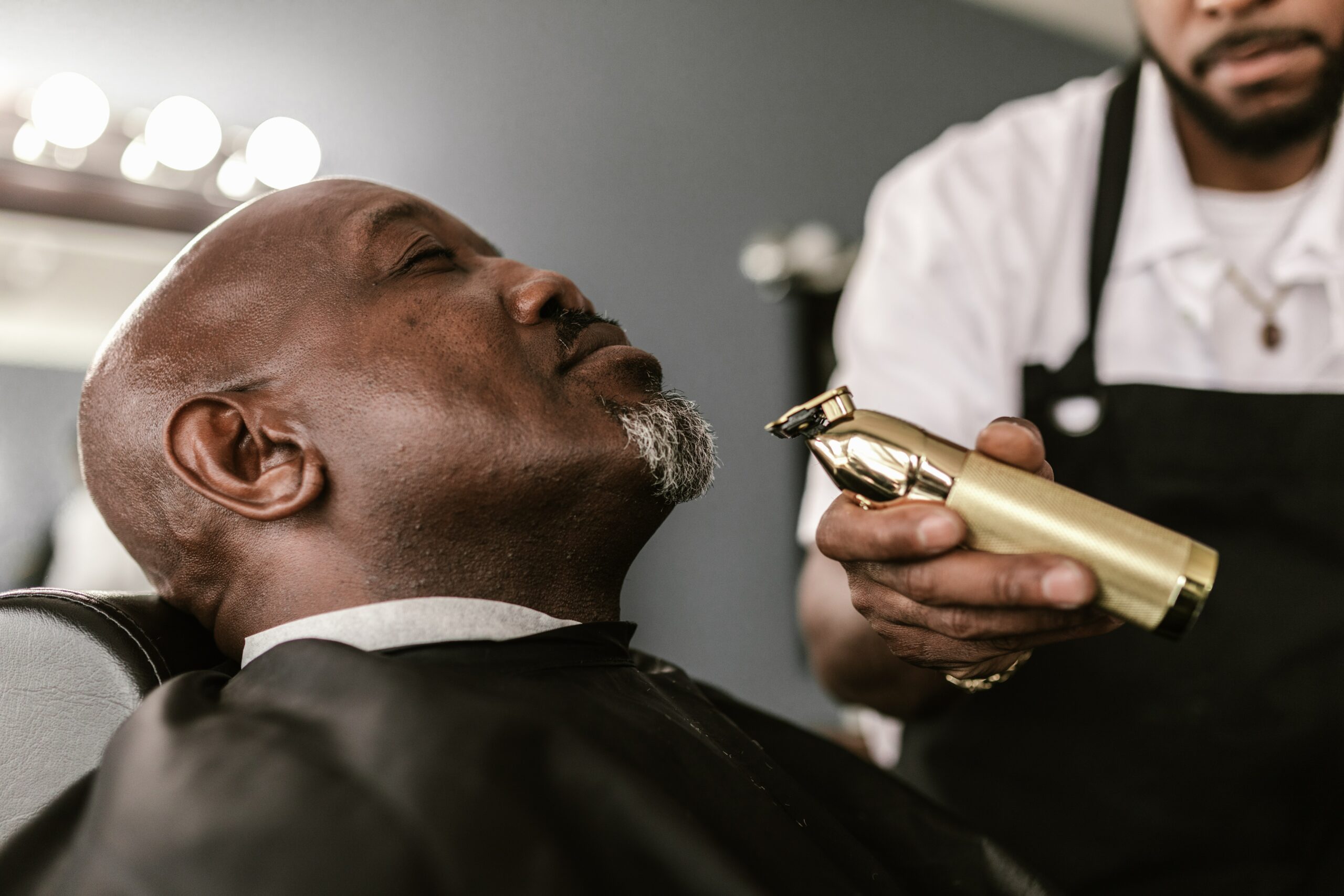
Have you ever noticed bumps on your face after shaving? If so, perhaps you’ve heard of razor bumps and assumed that’s what those little ingrown hair-like cysts were. But were they razor bumps? And what do razor bumps look like on the face?
Razor bumps look like small ingrown hair cysts. They may vary in color depending on a person’s skin tone. Typically, razor bumps are raised and irritated. The skin bump may look red, pink, or a darkened color. Sometimes, they become infected and may look yellow or whitish in the center.
So how do you know if you truly have razor bumps? Moreover, what can you do if it looks like razor bumps on your face? Keep reading if you or someone you know has had these facial bumps and you want to know more.
Razor bumps is the name of a skin problem that shows up on the face and neck after shaving. Usually, these bumps are small. Razor bumps typically measure only 2 to 5 mm in diameter.
If you notice bumps on your face, you can look closely at the face with a mirror. The small cysts will appear near hair roots. Watch for signs of irritation at the hair root. Signs of razor bumps on the face can include:
Facial hairs cut with sharp edges, like a razor blade, can grow back into the skin. As a result, a shiny hump or cyst forms on the face. They are also called shave bumps or barber’s bumps.
Men with coarse or tightly curled hair see razor bumps more often. This hair type grows easily back into the skin after shaving. More than half of African American men have had this condition.
Only a licensed physician can diagnose razor bumps. If you have signs of these barber bumps and they don't go away, it's best to talk to a doctor.
The medical term for razor bumps is Pseudofolliculitis Barbae. Traumatic folliculitis of the beard is another name for it, even though razor bumps can appear in other body parts. The condition is caused by shaving. Hence the name, razor bumps.
Bad shaving habits can worsen razor bumps. For example, pulling the skin tightly or pressing on the razor while shaving can cause hairs to be cut too short. It can aggravate razor bumps. Also, using dull razor blades can cause trauma to the skin. They pull the hair shaft during shaving, which can worsen razor bumps.
Also, men who suffer from razor bumps find that shaving too frequently makes matters worse. If you suspect you have razor bumps on the face, you should avoid shaving the affected area until it is healed.
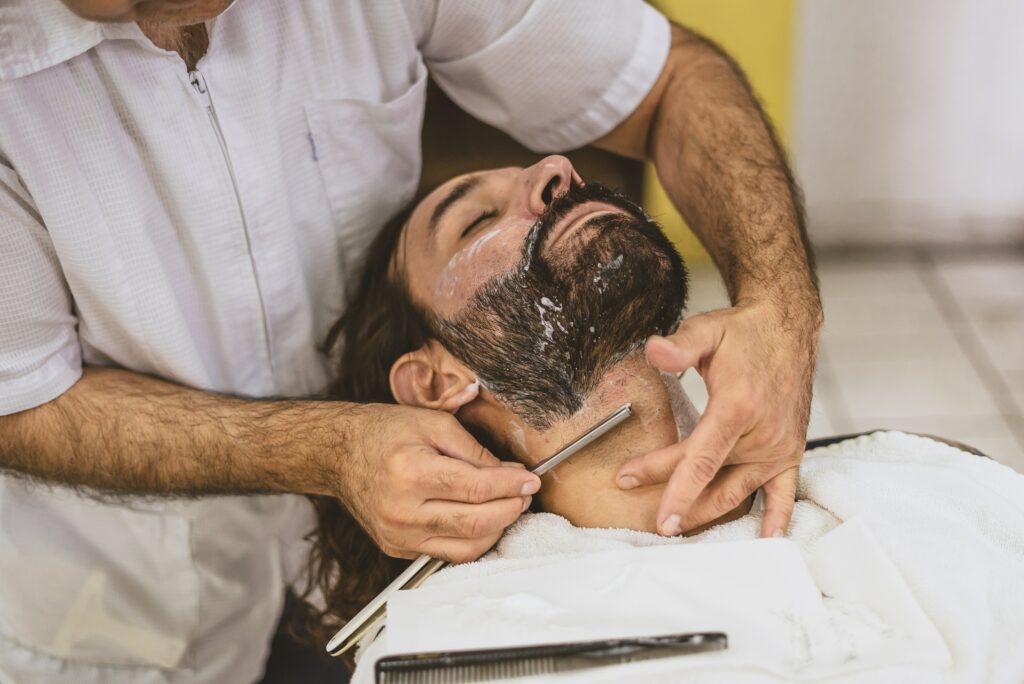
You can do several things if you think you have razor bumps. Some you can do at home by yourself. Others may require you to see a doctor.
The easiest and most effective way to treat razor bumps is to stop the cause of the problem. Yes, you guessed it. That means to stop shaving. Allowing facial hair to grow freely can stop the irritation. According to the American Osteopathic College of Dermatology, letting a beard grow naturally is a 100% effective treatment.
Another solution is to train the hair. Some doctors recommend brushing facial hair to encourage it to grow a certain way. Doing so may decrease razor bumps.
A beard brush can help tame unruly hairs. Starting near the ears and brushing down toward the chin in smooth strokes can encourage hairs to grow out straight. Men should brush face hair at least once a day.
The third solution for razor bumps on your face is to try changing up your shaving routine. Try different products or methods to reduce bumps.
Softening the hairs before shaving in the shower or with a hot wet towel on the face helps. Men can also look for lubricating shave gels or try an electric razor. Different methods can help lessen bumps.
If you try these at-home solutions but still have a hard time with razor bumps, then it might be time to talk to a doctor.
So now you know how to prevent bothersome bumps on your face and how to tell if you’re dealing with razor bumps. The ingrown hair-like cysts on their face can vary slightly from person to person. Still, razor bumps are usually swollen, discolored, and bothersome.
If you are still unsure you have razor bumps on your face and want to talk to an expert, go ahead and chat with us to find out more about Razorbumps, Inc. We have top board-certified physicians available to see and treat your skin problem by video appointment now. To find out more, click BOOK APPOINTMENT.
Disclaimer: The contents of this article are for informational purposes only and do not constitute medical advice. The information, graphics, and images on this site are not intended to substitute diagnosis or treatment by a medical professional. Always seek the advice of a licensed physician for any questions you may have regarding a specific condition.